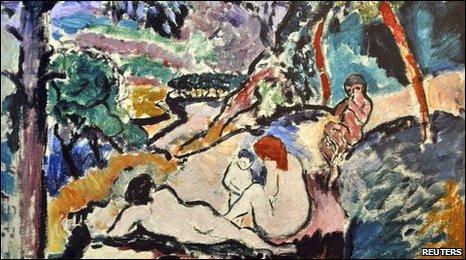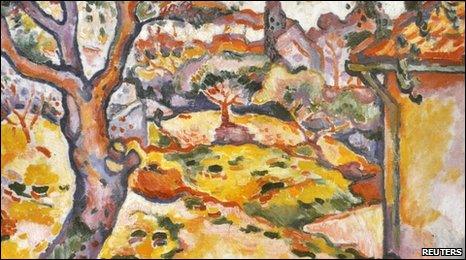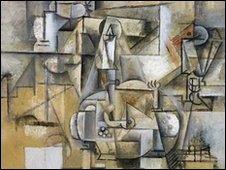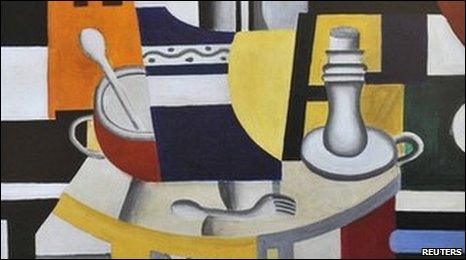Five masterpieces stolen from Paris modern art museum
- Published
Five paintings by Picasso, Matisse and other great artists have been stolen from the Museum of Modern Art in Paris, French officials say.
The paintings are estimated to be worth just under 100m euros (£86m; $123m).
They were taken overnight on Wednesday and reported missing early on Thursday, officials say.
The museum, across the River Seine from the Eiffel Tower, has been cordoned off by investigators.
Security camera footage reportedly shows someone entering the museum through a window during the night.
"This is a serious crime to the heritage of humanity," Christophe Girard, deputy culture secretary at the Paris Town Hall, told a news conference.
The theft was committed by "one or more individuals who were obviously organised", Mr Girard said.
He added that investigators were looking into how the museum's security system and several guards were outsmarted by the thief or thieves.
Mr Girard put the value of the stolen paintings at just under 100m euros (£86m; $123m). They had earlier been estimated to be worth some 500m euros (£431m; $618m).
The five missing paintings are Dove with Green Peas by Pablo Picasso (painted in 1911), Pastoral by Henri Matisse (1906), Olive Tree near l'Estaque by Georges Braque (1906), Woman with Fan by Amedeo Modigliani (1919) and Still Life with Candlestick by Fernand Leger (1922).
Broken padlock
Museum officials discovered the theft early on Thursday, when they found a smashed window and a broken padlock which had been cut to gain access to the five paintings.
It is the biggest heist since the 1990 theft at the Isabella Stewart Gardner Museum in Boston of a Vermeer, several Rembrandts, Degas and other masterpiece.
None of these works has yet been recovered.
Though there is often speculation that works have been "stolen to order" for dishonest collectors, experts in the field say that in reality this is very unusual.
Investigators think that international criminal gangs use art works effectively as a form of currency.
For criminals dealing in drugs or weapons, a rolled-up painting is a way of carrying very large amounts of "currency", even if it is one tenth of the value at auction, the BBC's arts correspondent adds.
The Museum of Modern Art of the City of Paris, located in the east wing of the Palais de Tokyo building, is separate from the bigger and better-known national collection of modern art at the Pompidou Centre.
ANALYSIS: WHAT THE PICTURES TELL US.

If you wanted to start a museum of modern art these five paintings would be high on your list of acquisitions. Between them they tell the story of modern art's emergence, says the BBC arts editor Will Gompertz.
PASTORAL BY HENRI MATISSE (1906)

Pastoral painted by Henri Matisse in 1906
Henri Matisse's Pastoral has the hallmarks of the Impressionists - painted outside or "en plein air", with loose brushstrokes and an everyday, realistic subject.
What marks it out from the work of the early Impressionists is the bright, unnatural colours, which he has used to express the scene as he sees and feels it.
This was called Fauvism.
OLIVE TREE NEAR L'ESTAQUE - GEORGES BRAQUE (1906)

Olive Tree near l'Estaque painted by Georges Braque in 1906
Georges Braque was inspired by the work of Matisse and developed his own Fauvist style which can be seen in the painting Olive Tree Near L'Estaque.
What is of particular interest about this work is the date Braque painted it - 1906.
That is the year Paul Cezanne died, and it was his later paintings that inspired Braque to develop one of modern art's most famous movements.
By 1907, Braque was painting similar scenes but his style had changed.
Together with Picasso they had started to define Cubism.
DOVE WITH GREEN PEAS - PABLO PICASSO (1911)

Dove with Green Peas painted by Pablo Picasso in 1911
Picasso's Dove with Peas makes sense as the next painting to have, as it is a classic example of Cubism in its pomp.
By this stage Braque and Picasso had been joined by Fernand Leger as the other great exponent of Cubist art and techniques.
But Leger became disillusioned with the increasingly abstract nature of the Cubists' work.
During World War I, he chose to renounce abstraction and instead focus on painting common objects in bold colours.
STILL LIFE WITH CANDLESTICK - FERNAND LEGER (1922)

Still Life with Candlestick painted by Fernand Leger in 1922
As you can see in the next painting that was stolen - Still Life with Candlestick - Leger has retained the influence of Cubism while incorporating the saturated colours of the Fuaves.
But by combining the two and adding his artistic developments the work moves towards modernism.
Woman with Fan - Amedeo Modigliani (1919)

Woman with Fan painted by Amedeo Modigliani in 1919
Amedeo Modigliani was the fifth artist to be targeted by the thieves.
They chose a work he painted in 1919, Woman with Fan.
He died a year later at the age of 35, having contracted tuberculosis.
Modigliani's portrait of his friend shows him using restrained colours out of respect for her and using "S" shapes to accentuate her graceful pose.
As Matisse used colour to express his feelings for his subject, so Modigliani used distortion.
Both fit within the expressionist movement inspired by the work of Vincent Van Gogh.